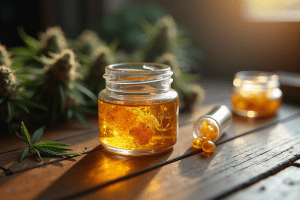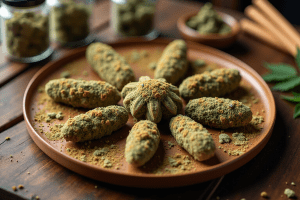Overview
This article invites you to explore the fascinating world of white weed, a strain distinguished by its high concentration of trichomes that create a frosty appearance. This characteristic is often linked to higher potency and desirable effects, making it essential for both consumers and cultivators to understand.
Have you ever wondered how trichome density influences the quality of cannabis? Strains like White Widow exemplify the popularity of white weed, highlighting the importance of these tiny structures in the evolving marijuana market.
Together, let’s navigate this journey to make informed choices that enhance your experience.
Introduction
In the ever-evolving world of cannabis, have you noticed how white weed has become a captivating phenomenon? Its striking frosty appearance, a result of dense trichome coverage, draws the attention of both enthusiasts and casual consumers alike. These strains not only offer aesthetic appeal but are also celebrated for their potent effects.
From the legendary White Widow to the lesser-known albino varieties, the allure of white weed lies in its rich history and unique characteristics. As consumer demand for high-quality cannabis grows, understanding the intricacies of white weed becomes essential. Together, we can navigate the complex landscape of cannabis cultivation and consumption, ensuring informed choices that resonate with our needs.
Defining White Weed: A Comprehensive Overview
Pale weed, a term often used in our marijuana community, refers to varieties that showcase a frosty, light hue due to a high concentration of trichomes—tiny, glandular structures that produce cannabinoids and terpenes. This unique visual trait is especially noticeable in well-known varieties like White Widow and The White. Additionally, the term can encompass albino cannabis plants, which lack chlorophyll, resulting in pale leaves and buds.
Understanding white weed is important for consumers who wish to identify potent varieties and appreciate the intricacies of cannabis cultivation. The appeal of white weed varieties stems partly from their beautiful appearance and the belief that they offer greater potency, as seen in consumer preferences. For example, White Widow seeds are cherished by both professional and home growers for their stability and impressive THC content, consistently delivering quality results across various growing conditions. This legendary strain continues to draw the interest of both recreational and medical cultivators, reinforcing its esteemed position in the marijuana market.
The density of trichomes significantly influences the popularity of marijuana strains. Strains with a higher trichome density are often preferred for their enhanced potency and flavor profiles. Recent data shows that many marijuana users are aware of light-colored strains, highlighting their popularity in the market. Notably, 79% of Americans live in a county with at least one marijuana dispensary, emphasizing the availability of marijuana and its significance in our community. Furthermore, the illegal marijuana market in North America is projected to decrease to $59.5 billion by 2025, reflecting the evolving dynamics of marijuana use and its impact on light weed varieties. Experts stress the importance of trichomes in determining the quality and effects of the plant, highlighting their role in cultivation and consumer choice. As the marijuana landscape evolves, focusing on white weed remains essential for both cultivators and consumers as we navigate the complexities of variety selection together.
Contextualizing White Weed in the Cannabis Industry
White weed, along with other light-colored cannabis varieties, has become increasingly popular in the industry. This rise is largely due to its eye-catching visual allure and strong effects that many find appealing. These varieties often showcase a dense coating of trichomes, drawing in both inexperienced and experienced users alike. Iconic strains, such as White Widow, have established themselves as staples in dispensaries, celebrated for their balanced effects and elevated THC levels. This growing preference for white weed varieties reflects broader trends in marijuana cultivation, where breeders focus on enhancing resin production to improve both visual appeal and potency.
Have you noticed how visually attractive marijuana can influence your choices? Market analysis reveals that a significant 64% of users prioritize mental effects, closely followed by physical effects at 57%. This trend encourages dispensaries to adapt their marketing strategies, highlighting the aesthetic qualities of their products to attract customers. Additionally, the global medical marijuana market is projected to grow at a CAGR of 7.1% from 2025 to 2033, underscoring the increasing importance of white weed varieties in this evolving landscape.
As developed markets like California, Oregon, Washington, and Colorado experience a decline in year-over-year marijuana sales, understanding consumer preferences becomes essential. The findings from the case study titled ‘Consumer Preferences for Cannabis Effects’ show how varieties of white weed align with the mental effects sought by 64% of users, enhancing their appeal. As the cannabis market evolves, the prominence of light-colored cannabis varieties not only reflects consumer preferences but also shapes the industry’s strategies for product development and marketing. Together, we can ensure that these varieties remain a focal point in this competitive environment.
Tracing the Origins and Evolution of White Weed
The beginnings of pale cannabis can be traced back to the early 1990s, when Widow, a hybrid variety developed in the Netherlands by breeder Shantibaba, was introduced. This remarkable variety emerged from the blend of a Brazilian sativa landrace and a South Indian indica, resulting in a product celebrated for its abundant resin production and balanced effects. However, achieving high yields with Widow can be challenging without specific growing strategies. White Widow quickly gained popularity, establishing itself as a cornerstone in the marijuana community and inspiring a wave of new pale varieties, such as The White, White Rhino, and other forms of white weed. These varieties not only exhibit a unique frosty appearance but also deliver strong effects, reflecting an increasing emphasis on resin production in cannabis cultivation methods.
The evolution of white weed varieties showcases significant advancements in breeding techniques aimed at enhancing resin yield and potency. Historical perspectives from breeders reveal the complexities involved in developing these strains, particularly the challenges of maintaining genetic integrity while pursuing desirable traits. A notable case study on the breeding history of Widow illustrates the conflicting narratives surrounding its lineage, highlighting how ego and greed can sometimes obscure the truth and impact the reputations of those involved.
Today, the Widow strain stands as a benchmark in the cannabis industry, characterized by its dense buds, high THC content, and low CBD levels, often accompanied by earthy aromas of cedar and pepper. As Patrick, a founder and grower at Learn Sativa University, observes, “The variety’s energizing characteristics make it a favorite for daytime use, potentially enhancing productivity and social interaction.” As the market continues to evolve, the heritage of Widow and its descendants will undoubtedly shape future breeding efforts and consumer choices, establishing a standard for other pale varieties.
Have you ever considered how these strains might enhance your own experiences? Together, we can explore the rich history and future potential of cannabis varieties, ensuring informed choices that resonate with our needs and desires.
Identifying Key Characteristics of White Weed
White weed varieties captivate with their dense trichome coverage, giving them a frosty appearance that is truly striking. This high resin content not only enhances their visual allure but also indicates elevated cannabinoid levels, especially THC. Many of these varieties are known for their potent effects, often offering a delightful blend of mental stimulation and physical relaxation. Have you ever experienced a strain that perfectly balances these qualities?
Flavor profiles among these strains can vary significantly. Some feature subtle earthy undertones, while others present a more pronounced sweetness. For instance, one strain is celebrated for its balanced effects and rich flavor, while another variant stands out for its potency and distinct lack of scent. It’s fascinating how each strain can offer a unique experience.
Notably, The White is classified as a medium to heavy feeder, an important consideration for growers. According to Vaping360.com, which has evaluated over 1500 products, the potency and effects of these varieties are well-documented, reinforcing their popularity among consumers. By understanding these key characteristics and considering consumer reviews, we can better appreciate the diversity and complexity within the realm of white weed varieties.
As Deepak Cyril Dsouza emphasizes, understanding the consequences of cannabis use is crucial. This knowledge extends to recognizing the unique attributes of different strains. Together, we can explore these options and make informed choices that resonate with our individual needs.
Conclusion
The captivating phenomenon of white weed is more than just an appealing aesthetic; it signifies a meaningful evolution in cannabis cultivation and consumer preferences. With their dense trichome coverage, strains like White Widow and The White are not only celebrated for their potent effects but also for their unique flavor profiles. As we observe the increased demand for these visually striking strains, we see a broader trend in the cannabis market where consumers are prioritizing both appearance and potency in their selections.
As the cannabis industry adapts to our shifting behaviors and preferences, white weed strains have become central players in this landscape. Their ability to deliver a balanced blend of mental stimulation and physical relaxation makes them particularly appealing. Market analyses reveal that many users appreciate this balance, highlighting the importance of these strains in our choices. Additionally, the ongoing evolution of breeding techniques aimed at enhancing resin yield shows just how vital white weed is in shaping the future of cannabis products.
Understanding the intricacies of white weed enriches our consumer experience and emphasizes the need for informed choices in the ever-expanding cannabis landscape. As this segment of the market continues to grow, the legacy of iconic strains like White Widow will undoubtedly influence both cultivation practices and consumer trends. Together, we can ensure that white weed remains a focal point for enthusiasts and novices alike, guiding us towards a more informed and enjoyable cannabis journey.
Frequently Asked Questions
What is pale weed?
Pale weed refers to cannabis varieties that exhibit a frosty, light hue due to a high concentration of trichomes, which are tiny structures that produce cannabinoids and terpenes.
Which cannabis varieties are commonly associated with pale weed?
Well-known varieties that showcase pale weed characteristics include White Widow and The White.
What are albino cannabis plants?
Albino cannabis plants are those that lack chlorophyll, resulting in pale leaves and buds.
Why is understanding white weed important for consumers?
Understanding white weed helps consumers identify potent varieties and appreciate the intricacies of cannabis cultivation.
What makes white weed varieties appealing to consumers?
The appeal of white weed varieties stems from their beautiful appearance and the belief that they offer greater potency, which influences consumer preferences.
Why are White Widow seeds popular among growers?
White Widow seeds are cherished for their stability and impressive THC content, consistently delivering quality results across various growing conditions.
How does trichome density affect marijuana strain popularity?
Strains with a higher trichome density are often preferred for their enhanced potency and flavor profiles, influencing their popularity in the market.
What percentage of Americans live in areas with marijuana dispensaries?
Approximately 79% of Americans live in a county with at least one marijuana dispensary.
What is the projected trend for the illegal marijuana market in North America by 2025?
The illegal marijuana market in North America is projected to decrease to $59.5 billion by 2025.
Why are trichomes significant in cannabis cultivation and consumer choice?
Trichomes play a crucial role in determining the quality and effects of cannabis, making them important for both cultivators and consumers in their selection process.
Get Your Medical Card
Connect with a licensed physician online in minutes












